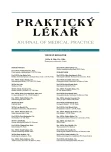Haemorrhoids and their treatment
Authors:
Z. Adamová
Authors‘ workplace:
Primář: MUDr. Jaroslav Sankot
; Vsetínská nemocnice a. s., Chirurgické oddělení
Published in:
Prakt. Lék. 2012; 92(10-12): 543-545
Category:
Various Specialization
Overview
Haemorrhoids are one of the most common anorectal problems managed by various physicians, ranging from primary care providers to surgeons. The correct diagnosis followed by an adequate treatment are essential for the patient. This article reviews the aetiology, pathophysiology, clinical presentation and treatment of haemorrhoids, including nonoperative options, out patient-based procedures, and surgical interventions. Although haemorrhoids are a well-known disease, the exact pathophysiology of haemorrhoidal development is poorly understood. The abnormal dilatation and distortion of the vascular channel, together with destructive changes in the supporting connective tissue within the anal cushion is a paramount finding of haemorrhoids. Haemorrhoids are defined as the symptomatic enlargement and distal displacement of the normal anal cushions. The most common symptom of haemorrhoids is rectal bleeding associated with bowel movement. Basic life-style recommendations have been the same for years, but pharmacotherapy and surgical techniques are changing. The aim of this text is to offer an overview about the current possibilities.
Key words:
haemorrhoids, anal bleeding, haemorrhoidectomy
Sources
1. Han, W., Wang, Z. J., Zhao, B., et al. Pathologic change of elastic fibers with difference of microvessel density and expression of angiogenesis-related proteins in internal hemorrhoid tissues. Zhonghua Wei Chang Wai Ke Za Zhi, 2005;8(1): p. 56–59.
2. Acheson, A. G., Scholefield, J. H.: Management of haemorrhoids. BMJ 2008; 336: p. 380–383.
3. Aigner, F., Gruber, H., Conrad, F., et al.: Revised morphology and hemodynamics of the anorectal vascular plexus: impact on the course of hemorrhoidal disease. Int J Colorectal Dis. 2009; 24(1): p. 105–113.
4. Alonso-Coello, P., Zhou, Q., Martinez-Zapata, M. J., et al.: Meta-analysis of flavonoids for the treatment of haemorrhoids. Br J Surg 2006; 93: p. 909–920.
5. Anděl, P., Dostalík, J., Pelikán A.: 10 let zkušeností s Barronovou ligaturou na chirurgické klinice Ostrava. Rozhl. Chir., 2007, roč. 86, č. 8, s. 428–431.
6. Anděl, P., Škrovina, M., Ducháč, V.: Základy praktické proktologie. Praha: Galén, 2012. 220 s. ISBN 9788072628926.
7. Bat, L., Melzer, E., Koler, M., et al.: Complications of rubber band ligation of symptomatic internal hemorrhoids. Dis Colon Rectum 1993; 36: p. 287–290.
8. Bayer, I., Myslovaty, B., Picovsky, B. M.: Rubber band ligation of hemorrhoids. Convenient and economic treatment. J Clin Gastroenterol 1996; 23: s. 50–52.
9. Burch, J., Epstein, D., Baba-Akbar, A., et al.: Stapled haemorrhoidectomy (haemorrhoidopexy) for the treatmentof haemorrhoids: a systematic review and economic evaluation. Health Technol Assess 2008; 12(8): iii-iv, ix-x, 1–193.
10. Hoch, J.: Hemoroidy. Interní Med. 2002; 9: s. 441–446.
11. Kasher, J. A., Mathisen, G.: Acquiring tetanus after hemorrhoid banding and other gastrointestinal procedures. J Gastrointest Surg 2007; 11(4): p. 515–519.
12. Král, J.: Longova metoda operace hemoroidů a prolapsu sliznice anorekta (PPH) – zkušenosti 8 let. Rozhl. Chir., 2007, roč. 86, č. 12, s. 678–679.
13. Nisar, P. J., Scholefield, J. H.: Managing haemorrhoids. BMJ 2003; 327(7419): p. 847–851.
14. Santos, G., Novell, J. R., Kňoury, G., et al.: Long-term results of large-dose, single-session phenol injection sclerotherapy for hemorrhoids. Dis Colon Rectum 1993; 36: p. 958–961.
15. Schubert, M. Ch., Sridhar, S., Schode, R. R, et al.: What every gastroenterologist needs to know about common anorectal disorders. World J Gastroenterol 2009; 15(26): p. 3201–3209.
16. Vlček, P., Korbička, J., Diviš, P., a kol.: Co nového v léčbě hemoroidů? Med. Pro Praxi 2010; 7(1): s. 9–13.
Labels
General practitioner for children and adolescents General practitioner for adultsArticle was published in
General Practitioner

2012 Issue 10-12
- Metamizole vs. Tramadol in Postoperative Analgesia
- Metamizole at a Glance and in Practice – Effective Non-Opioid Analgesic for All Ages
- Memantine in Dementia Therapy – Current Findings and Possible Future Applications
- Memantine Eases Daily Life for Patients and Caregivers
- What Effect Can Be Expected from Limosilactobacillus reuteri in Mucositis and Peri-Implantitis?
Most read in this issue
- Haemorrhoids and their treatment
- Sex life of seniors living in social service homes
- Primary care and health promotion in the Czech Republic
- Anonymous donation of gametes and anonymous births: common ethical, psychosocial and legal aspects
